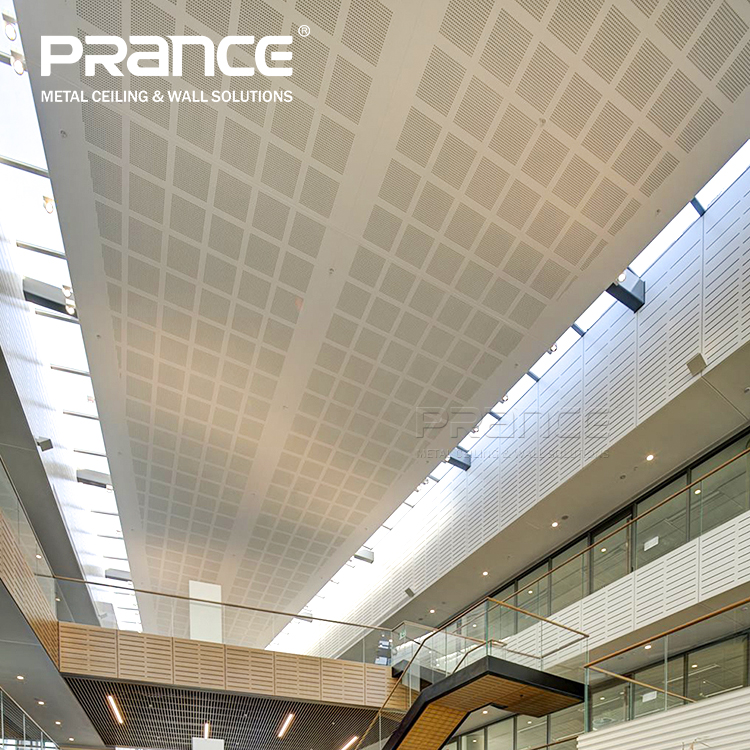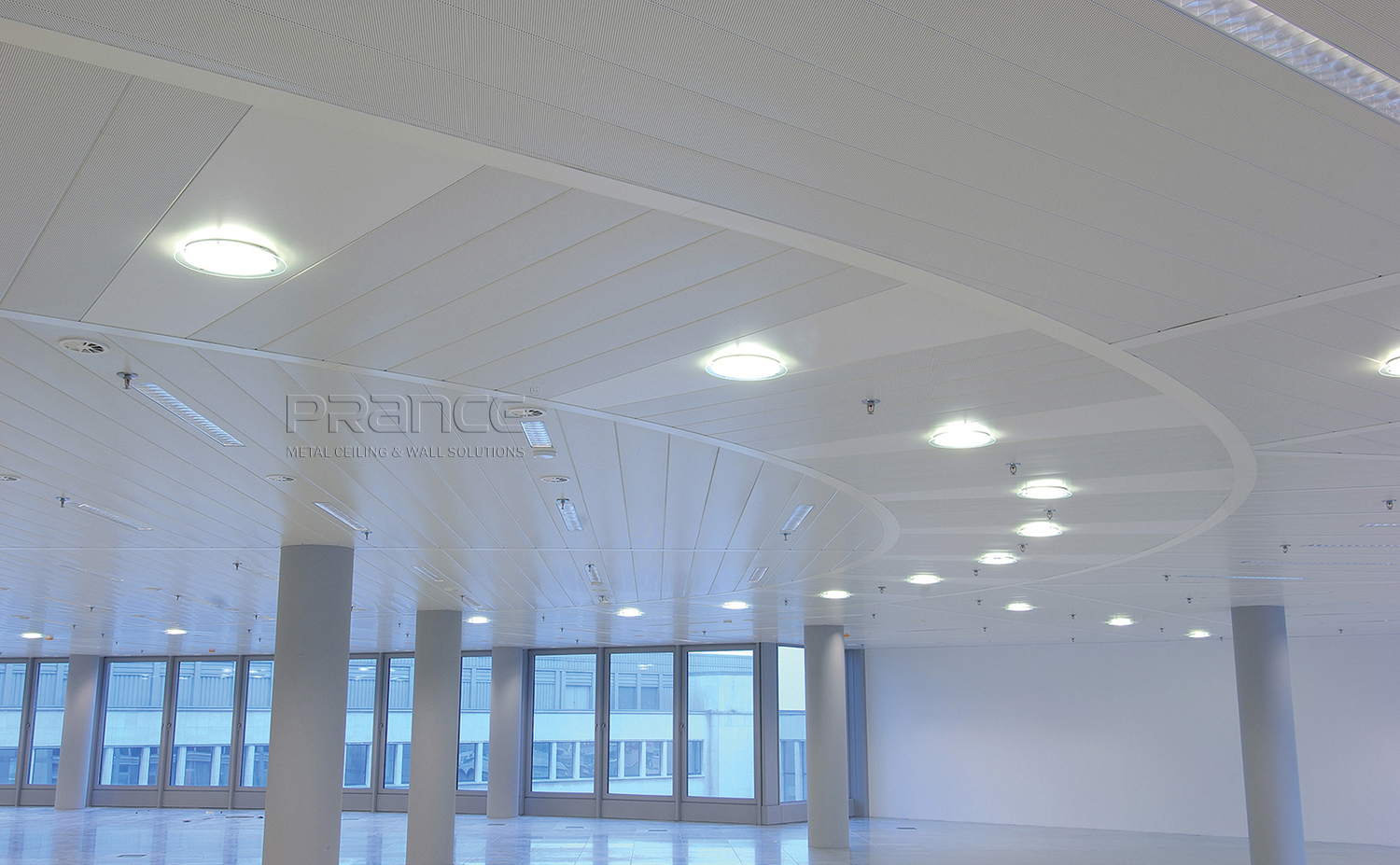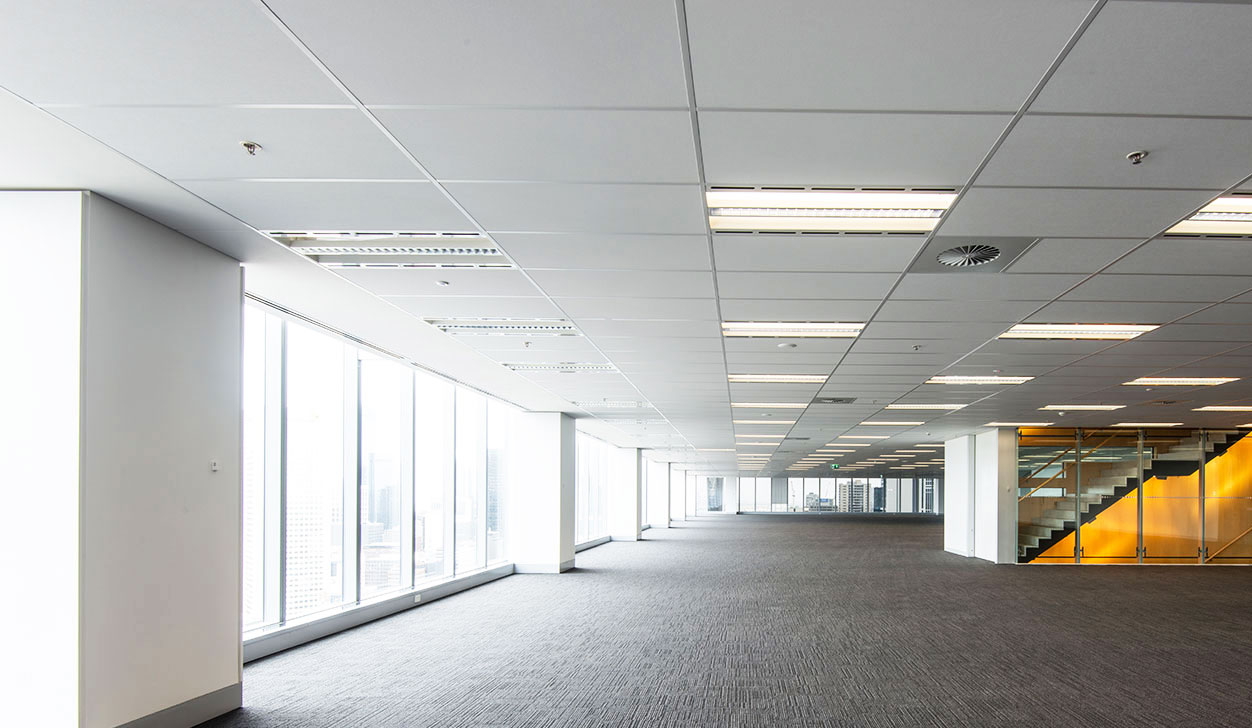PRANCE metalwork is a leading manufacturer of metal ceiling and facade systems.
Ceiling Suspended Systems: Stylish and Functional
The contemporary design landscape features ceiling suspended systems, which provide outstanding functionality with remarkable visual appeal. The systems demonstrate adaptability that enables designers, along with architects, to develop aesthetic solutions for improving space design capabilities. These suspended ceiling systems continue to gain popularity because they provide sustainable solutions that now find application in both residential areas and commercial and industrial facilities. This paper examines how such systems transform spaces by enhancing functionality as well as improving design visual appeal.
1. What is a Suspended Ceiling System?

Lower ceiling suspended systems exist beneath the ceiling level, serving dual purposes of housing decorative elements and functional necessities. Suspended ceiling tiles and hanger systems provide a method to restyle space functionality while reshaping aesthetic outcomes. These suspended ceiling systems represent a unique combination of functional design elements, which make them the leading solution for contemporary architectural needs.
2. Why Suspended Ceiling Important?
Ceiling suspended systems provide dual advantages by improving the space's visual appeal in combination with practical solution capabilities. The systems hide electrical connections along with ductwork and other structural defects to identify a space with clean lines and order. Analysis shows that these systems improve both acoustic performance and integration capabilities while providing effective thermal insulation, making rooms stylish while remaining efficient.
Versatility in Design
These systems provide versatile design options that make them appropriate for any room. Different ceiling-suspended systems exist to support multiple design preferences, including complex patterns along with modern minimalistic design choices. Different materials, including metal, wood, and gypsum, form the basis of distinctive design languages. Lighting fixtures can fit on these systems because of their design flexibility.
Functional Benefits
Your practical advantages emerge from the smart design function of acoustic suspended ceiling systems. Rooms become more acoustically efficient due to sound absorption properties, which make these options perfect for places such as class spaces and offices, along with auditorium spaces. The insulation features of such systems enable energy efficiency along with the capability to optimize HVAC system performance.
Click on the video below to learn more about the versatility and load-bearing capacity of suspended ceiling tiles.
3. Applications of Ceiling Suspended Systems
Residential Spaces
When installed in residential spaces, suspended ceiling systems enhance both the room's beauty and its distinctive character. These lighting fixtures create visual interest in dining rooms as well as living areas by providing unique focal points while integrating soft illumination into environments. Through their implementation, these systems partition open spaces while creating meaningful visual boundaries.
Commercial Environments
Business environments, together with retail spaces and restaurants, depend on suspended architectural systems to combine professional appeal with inviting feelings. These spaces use high-end design elements to hide crucial hardware systems, thus providing modern and functional environments. Businesses can customize their suspended ceiling ideas through available options to match their branding expressions.
Industrial Settings
These systems find application in industrial spaces to achieve soundproofing requirements and utility hiding functions and to enhance energy efficiency both functionally and aesthetically. Their flexible design, together with simplified maintenance procedures, makes these products perfect for use in industrial facilities and warehouses.
4. Popular Types of Ceiling Suspended Systems

Suspended Ceiling Tiles
Acosutic suspended ceiling systems stand as the dominant selection. The tiles maintain lightweight qualities, which allow for simple installation using modular structures. Design options are unlimited due to their range of available finishing options and different textures. Results from their effective acoustic control features and their capability to hide building infrastructure establish them as highly practical ceiling solutions.
Linear Ceiling Systems
Linear systems work through their long, narrow panel design to deliver modern, sleek looks. Utilities encounter high demand in sophisticated residential along commercial constructions due to their minimalistic design and modern appearance. Linear ceiling systems function both as acoustic regulators and serve for lighting integration.
Customizable Modular Systems
The built-in flexibility of modular systems enables architects to create custom solutions for odd or one-of-a-kind areas. Through material exploration and pattern work alongside color combinations, architects develop unique ceiling designs. Because of their adaptable design, modular systems will conform to any functional need.
5. How to Install a Suspended Ceiling System
Planning and Design
The successful implementation of the installation depends heavily on well-planned design efforts. The selected materials and layout depend on how ceiling suspended systems must function. Building accuracy means the system will fit directly into its designated area without any inconvenience.
Professional Installation
Expert installation produces systems that last longer while delivering the best performance results. Belong to experienced installers who make sure every part of the structure remains firmly fixed while all elements stay correctly aligned. The installation step serves two vital functions: preserving system integrity and stopping future problems.
Maintenance and Upkeep
The durability of ceiling-suspended systems depends fundamentally on proper maintenance. Regular maintenance checks with cleaning operations discover and fix visible signs of damage to the system framework. Modular panels provide easy ongoing maintenance capabilities because you can replace single units without interrupting the rest of the installation.
6. Trends in Ceiling Suspended Systems for 2025

Smart Integration
Smart technology evolution leads ceiling-suspended systems to integrate motion sensors and automated lighting functions. New technological innovations produce systems that maximize operational effectiveness while offering improved user interfaces in spaces.
Sustainable Materials
Sustainable construction practices have resulted in an increasing use of environmentally friendly materials within ceiling suspension systems. Building professionals have started integrating recycled metals and bamboo with biodegradable composites as materials with low environmental impact. Green building standards accept these materials because they combine environmental friendliness with a beautiful appearance.
Innovative Designs
Current design movements create new possibilities for ceiling-suspended systems to reach their full potential. Every design style can draw from ceiling-suspended systems, which offer fathomless potential for three-dimensional geometry and artistic installations. These designs exist as both visual distractions and practical support elements.
Conclusion
Modern interiors now benefit from ceiling-suspended systems due to their blend of design flair with operational value. Ceiling suspended systems successfully adjust to various spaces, including residential and industrial sectors, which positions them as crucial foundation elements for contemporary architectural designs. The future looks bright for these systems because technology advances and sustainability grows, and they will become more innovative while belonging to essential functions.
FAQs
Q1.How do suspended grid ceiling systems enhance acoustic performance?
Suspended grid ceiling systems feature acoustic tiles that absorb sound waves, reducing noise and echoes. Acoustic suspended ceiling systems, like those with Rockwool insulation, are designed for environments where noise control is critical, such as offices and auditoriums. These systems help create quieter, more comfortable spaces by improving speech clarity and sound quality.
Q2. What are the benefits of using modular suspended ceiling systems in commercial spaces?
Modular suspended ceiling systems offer flexibility, allowing businesses to customize their designs to match branding or specific functional needs. With easy installation and maintenance, these systems can incorporate lighting, ventilation, and other utilities, making them perfect for dynamic commercial spaces.
Q3. Are acoustic suspended ceiling systems suitable for residential spaces?
Yes, acoustic suspended ceiling systems are ideal for residential areas, particularly in spaces like living rooms and home offices where noise control is essential. These systems enhance soundproofing by reducing noise from outside and minimizing echo. Additionally, they improve thermal insulation, contributing to a more comfortable and energy-efficient home environment.
Q4. Can suspended ceiling systems be customized to fit specific design needs?
Yes, suspended ceiling systems are highly customizable. Whether you need unique shapes, finishes, or perforation patterns, these systems can be tailored to match any design aesthetic. Customizable modular and grid ceiling systems allow architects and designers to create bespoke solutions, whether for branding, acoustics, or functional needs, ensuring the ceiling complements the overall space design.




















